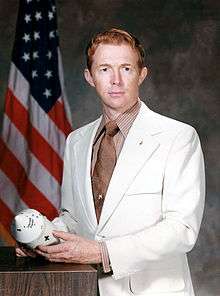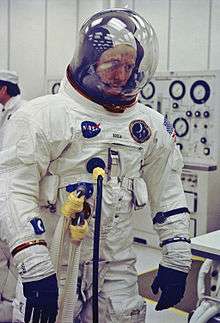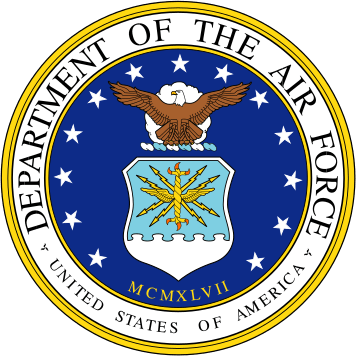Stuart Roosa
| Stuart A. Roosa | |
|---|---|
 Roosa in 1971 | |
| NASA Astronaut | |
| Nationality | American |
| Status | Deceased |
| Born |
August 16, 1933 Durango, Colorado, U.S. |
| Died |
December 12, 1994 (aged 61) Falls Church, Virginia, U.S. |
Other names | Stuart Allen Roosa |
Previous occupation | Fighter pilot, Test pilot |
|
Oklahoma State University of Arizona CU-Boulder, B.S. 1960 | |
| Rank | Colonel, USAF |
Time in space | 9d 00h 01m |
| Selection | 1966 NASA Group 5 |
| Missions | Apollo 14 |
Mission insignia |
|
| Retirement | February 1, 1976 |
| Awards |
|
Stuart Allen "Stu" Roosa (August 16, 1933 – December 12, 1994), (Col, USAF), was an American aeronautical engineer, United States Air Force pilot, test pilot, and NASA astronaut, who was the Command Module Pilot for the Apollo 14 mission. The mission lasted from January 31 to February 9, 1971 and was the third mission to land astronauts (Alan Shepard and Edgar Mitchell) on the Moon. While Shepard and Mitchell spent two days on the lunar surface, Roosa conducted experiments from orbit in the Command Module Kitty Hawk. He was one of only 24 people to travel to the Moon.
Biography
Early life and education
Roosa was born on August 16, 1933, in Durango, Colorado, to parents Dewey Roosa (1896–1990) and Lorine Roosa (née DeLozier; 1909–1993)[1] and grew up in Claremore, Oklahoma. He attended Justus Grade School and Claremore High School in Claremore, Oklahoma, from which he graduated in 1951; studied at Oklahoma State University and the University of Arizona and was graduated with honors and a Bachelor of Science degree in Aeronautical Engineering from the University of Colorado Boulder in 1960.
Military service
Roosa began his career as a smokejumper with the U.S. Forest Service, dropping into at least four active fires in Oregon and California during the 1953 fire season. He was a graduate of the Aviation Cadet Program at Williams Air Force Base, Arizona, where he received his flight training commission in the U.S. Air Force. He also attended the Aerospace Research Pilot School and was an experimental test pilot at Edwards Air Force Base in California before being selected for the astronaut class of 1966.
From July 1962 to August 1964, Roosa was a maintenance flight test pilot at Olmstead Air Force Base, PA, flying F-101 aircraft. He was a fighter pilot at Langley Air Force Base, VA, where he flew the F-84F and F-100 aircraft. Following graduation from the University of Colorado, under the U.S. Air Force Institute of Technology Program, he served as Chief of Service Engineering (AFLC) at Tachikawa Air Base, Japan, for two years.[2]
NASA career

Roosa was one of 19 people selected as part of the astronaut class of 1966. He was the CAPCOM at the Launch Complex 34 blockhouse during the Apollo 1 fire on 27 January 1967.[3] In 1969, he served as a member of the astronaut support crew for the Apollo 9 mission.
On Apollo 14 he spent 33 hours in solo orbit around the Moon, conducting an extensive series of experiments. On the Apollo 14 mission Roosa carried seeds from loblolly pine, sycamore, sweet gum, redwood, and Douglas fir trees as part of a joint U.S. Forest Service/NASA project. The seeds were germinated on his return and planted throughout the United States, becoming known as the "Moon Trees".[4]
Following Apollo 14, Roosa served as backup Command Module Pilot for Apollo 16 and Apollo 17, and based on crew rotations, would probably have commanded one of the last Apollo missions had it not been cancelled. He was assigned to the Space Shuttle program until his retirement as a Colonel from the Air Force in 1976.
He logged 5,500 hours of flying time; 5,000 hours in jet aircraft. He also logged 217 hours in space.
Post-NASA career
After leaving NASA and the Air Force, he held a number of positions in international and U.S. businesses, and became owner and president of Gulf Coast Coors in 1981. He completed the Harvard Business School's Advanced Management Program in 1973.
Death
On December 12, 1994, Stuart Roosa died at age 61 in Washington D.C. from complications of pancreatitis. He was survived by his wife Joan, three sons and a daughter, and seven grandchildren. Son Jack Roosa attended the USAF Academy and became an F-16 squadron commander. His youngest son, Stuart, Jr., known as, Allen, graduated from West Point in 1984 and served as an M1A1 tank company commander in Germany during the fall of the Berlin Wall and the collapse of the Eastern Block countries in Europe.
Roosa is buried in section 7A of Arlington National Cemetery.[5] His wife Joan died on October 30, 2007 in Gulfport, Mississippi. She was interred at Arlington Cemetery with her husband.[6]
Organizations
Roosa's memberships include the Society of Experimental Test Pilots, New York Safari Club, Board of Directors, People-to-People Sports Committee, Hunting Hall of Fame, Circumnavigators Club, Explorers Club, Confederate Air Force, Shikar-Safari-Club and Gulfport Yacht Club.
Awards and honors
Roosa's honors include the NASA Distinguished Service Medal; the MSC Superior Achievement Award (1970); the Air Force Command Pilot Astronaut Wings; the Air Force Distinguished Service Medal; the Arnold Air Society's John F. Kennedy Award (1971); the City of New York Gold Medal (1971); the American Astronautical Society's Flight Achievement Award (1971); the Order of Tehad (1973); and the Order of the Central African Empire (1973). Additionally, an elementary school in Claremore, Oklahoma is named in his honor. He received an honorary LL.D. from University of St. Thomas, Houston in 1971. He was inducted into the International Space Hall of Fame in 1983, and the U.S. Astronaut Hall of Fame in 1997.[7]
In media
- In the HBO miniseries From the Earth to the Moon (1998), Roosa was played by George Newbern.[8]
- The book Smoke Jumper, Moon Pilot (2011), by Willie G. Moseley, is a biography on Roosa's life.[9]
- In 2013, footage of Roosa's son holding a photo of Roosa with two of his granddaughters[10] appears in USAA insurance television ads promoting availability to family members.[11] In 2014, a USAA radio ad featuring Roosa's son ran on many U.S. radio stations.
References
- ↑ Roosa's parents,
- ↑ Roosa's flight experience
- ↑ Shayler, David (2002-01-01). Apollo: The Lost and Forgotten Missions. Springer Science & Business Media. p. 131. ISBN 9781852335755.
- ↑ "Houston, We Have Moon Trees". Peeling Back the Bark. Forest History Society. February 17, 2011.
- ↑ "Stuart Roosa". Find a Grave. January 1, 2001.
- ↑ Patricia Langley Harvey (November 2, 2007). "Joan Carol Barrett Roosa". Find a Grave.
- ↑ Stuart Roosa inducted into the U.S. Astronaut Hall of Fame
- ↑ Credits, From the Earth to the Moon (1998 miniseries)
- ↑ Moseley, Willie G. (2011-10-31). Smoke Jumper, Moon Pilot. Acclaim Press. ISBN 978-1935001768.
- ↑ "USAA TV Spot, 'Earned'". iSpot TV.
Screenshot
- ↑ "Mine Was Earned — USAA Auto Insurance". YouTube. USAA. October 2, 2013.
Bibliography
- Steitz, David E.; Herring, Kyle (December 12, 1994). Apollo Astronaut Stuart Allen Roosa Dies. Press release 94-210. NASA. Retrieved 23 December 2013.
External links
| Wikimedia Commons has media related to Stuart Roosa. |
- Roosa's official NASA biography
- Astronautix biography of Stuart Roosa
- Spacefacts biography of Stuart Roosa
- About Stuart Roosa
- Roosa at Spaceacts
- Stuart Roosa at the Internet Movie Database
- Roosa at Encyclopedia of Science
- Joan Barrett Roosa Obituary
- Roosa at International Space Hall of Fame
- "Houston, We Have Moon Trees". Peeling Back the Bark blog, the Forest History Society.
- Arlington Cemetery biography and photos
- Stuart Roosa at Find a Grave
